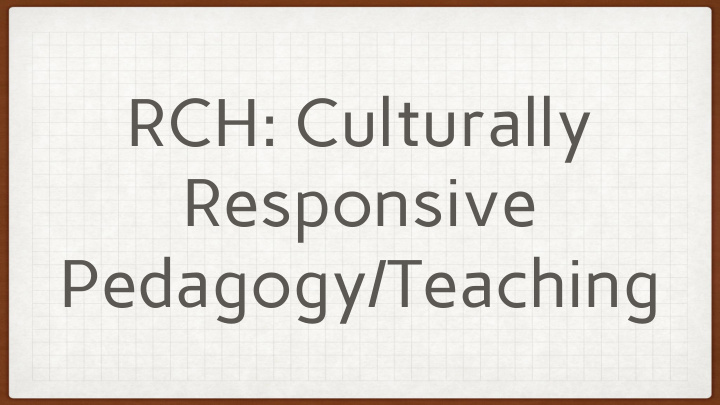



RCH: Culturally Responsive Pedagogy/Teaching
THERE ARE THREE (3) DOCUMENTS THAT ALIGN WITH THE SSRSB RCH POLICY 2) Human SSRSB Race, 1) Human 3)Provincial Rights Act Culture, Rights Act Code of of Nova Human of Canada Conduct Rights Policy Scotia
SSRSB Race, Culture and Human Rights Policy ● Learning environment safe to all students and staff ● Curriculum, assessment and teaching resources must be appropriate and inclusive to all students ● PD to teachers, students, community must be inclusive and anti-discriminatory ● Addressing incidents in an appropriate and timely manner ● Any violation goes through Code of Conduct or SSRSB Human Resources
Sometimes we teach based on, how we were taught in school, the culture that surrounded us etc.
How do we make sure that we teach using the lens that embodies multiple cultures so that everyone's story is told and valued.
Snowball Activity: What is Culturally Responsive Teaching vs Multicultural Education?
SO LET’S DIG DEEPER INTO CRT: Culturally Responsive Teaching (CRT) is the relationship builder. Kids change and so should how we teach them. Culture is the software to your brain's hardware - what raises my stress level is going to be seen through the lens of my cultural orientation (strengthening neural networks & avoiding pruning) A sense of connection in my culture might not be in another person's culture, so we have to know our kids Kids will not risk failure unless they feel safe: they must trust the one leading them to the edge of their learning.
Building Rapport is Foundational: Reframe the Student-Teacher relationship around trust Set the stage for “relaxed alertness” Recognize student will not risk failure unless they feel safe and trust the one leading them to the edge of their own learning
ACTIVITY: KNOWING, NAMING & CONFRONTING OUR BIAS
“Teaching doesn’t have to be that either I’m doing my instructional time or I’m doing this touchy-feely thing, because that is the view through an individualistic lens. That this is just technical and we just need to get down to business.” - Zaretta Hammond
Teaching and learning processes and structures: Use Discussion Protocols: Socratic seminar, world cafe, chalk talk, gallery walk, concentric circles… AKA - active talk , active engagement Liberating Structures: pairs, triads, jigsaw, groups, etc. Thinking Maps Journaling Personal Dictionaries Learning games: simulations, scavenger hunts, OPPORTUNITIES FOR ACCOUNTABLE TALK/LEARNING
REMEMBER... It is the children's way of knowing that should be the basis for instruction.
Recommend
More recommend